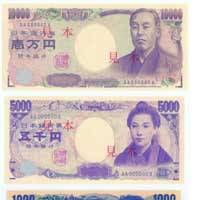The government will start replacing 10,000 yen, 5,000 yen and 1,000 yen bills with new notes that include sophisticated features to beat counterfeiters as early as April 2004, Finance Minister Masajuro Shiokawa announced Friday.
It will be the first replacement of bank notes since November 1984. The 2,000 yen bill, first issued in July 2000, will not be affected, Shiokawa told a news conference.
The new 5,000 yen bill will carry the portrait of Ichiyo Higuchi (1872-1896), a Meiji Era female novelist and poet, while the new 1,000 yen bill will feature microbiologist Hideyo Noguchi (1876-1928), who dedicated his life to research on infectious diseases, including yellow fever.
The new 10,000 yen bill will continue to bear the portrait of Fukuzawa Yukichi, although the design will be changed.
The bills will feature the latest anticounterfeiting technology, including holograms and a watermark bar, both of which have been incorporated into the new euro notes.
Other new technologies used in the 2,000 yen note, such as a latent image and iridescent ink, will also be used for the new notes.
The new bills will also have tactile marks for the visually impaired.
Bank notes are usually replaced every two decades, according to the ministry.
The 10,000 yen, 5,000 yen and 1,000 yen notes currently in circulation were first issued in November 1984. According to the Bank of Japan, there were 12.1 billion bank notes in circulation in Japan as of the end of 2001, with a value of 69 trillion yen.
The 10,000 yen bills account for 51.5 percent of the notes in circulation, and the 1,000 yen notes 29.3 percent. The 2,000 yen bills, which are just two years old, have the lowest circulation, of 300 million.
Shiokawa said the government hopes the new bills will have a social effect.
"We hope that the new paper money will bring a fresh atmosphere to the public," he said.



















With your current subscription plan you can comment on stories. However, before writing your first comment, please create a display name in the Profile section of your subscriber account page.